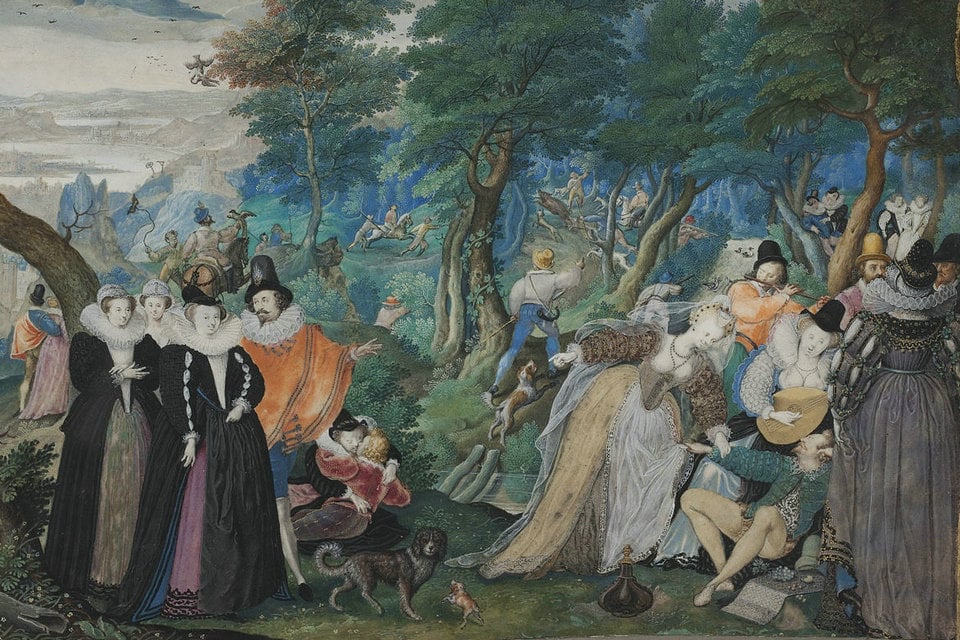Fashion in the period 1550–1600 in Western European clothing was characterized by increased opulence. Contrasting fabrics, slashes, embroidery, applied trims, and other forms of surface ornamentation remained prominent. The wide silhouette, conical for women with breadth at the hips and broadly square for men with width at the shoulders had reached its peak in the 1530s, and by mid-century a tall, narrow line with a V-shaped waist was back in fashion. Sleeves and women’s skirts then began to widen again, with emphasis at the shoulder that would continue into the next century. The characteristic garment of the period was the ruff, which began as a modest ruffle attached to the neckband of a shirt or smock and grew into a separate garment of fine linen, trimmed with lace, cutwork or embroidery, and shaped into crisp, precise folds with starch and heated irons.
General trends
Spanish style
Charles V, king of Spain, Naples, and Sicily and Holy Roman Emperor, handed over the kingdom of Spain to his son Philip II and the Empire to his brother Ferdinand I in 1558, ending the domination of western Europe by a single court, but the Spanish taste for sombre richness of dress would dominate fashion for the remainder of the century. New alliances and trading patterns arose as the divide between Catholic and Protestant countries became more pronounced. The severe, rigid fashions of the Spanish court were dominant everywhere except France and Italy. Black garments were worn for the most formal occasions. Black was difficult and expensive to dye, and seen as luxurious, if in an austere way. As well as Spanish courtiers, it appealed to wealthy middle-class Protestants. Regional styles were still distinct. The clothing was very intricate, elaborate and made with heavy fabrics such as velvet and raised silk, topped off with brightly coloured jewellery such as rubies, diamond and pearls to contrast the black backdrop of the clothing. Janet Arnold in her analysis of Queen Elizabeth’s wardrobe records identifies French, Italian, Dutch, and Polish styles for bodices and sleeves, as well as Spanish.
Linen ruffs grew from a narrow frill at neck and wrists to a broad “cartwheel” style that required a wire support by the 1580s. Ruffs were worn throughout Europe, by men and women of all classes, and were made of rectangular lengths of linen as long as 19 yards. Later ruffs were made of delicate reticella, a cutwork lace that evolved into the needlelaces of the 17th century.
Elizabethan Style
Since Elizabeth I, Queen of England, was the ruler, women’s fashion became one of the most important aspects of this period. As the Queen was always required to have a pure image, and although women’s fashion became increasingly seductive, the idea of the perfect Elizabethan women was never forgotten.
Elizabethan era had its own customs and social rules that were reflected in their fashion. Style would depend usually of social status and Elizabethans were bound to obey The Elizabethan Sumptuary Laws, which oversaw the style and materials worn.
The Elizabethan Sumptuary Laws were used to control behavior and to ensure that a specific structure was maintained. These set of rules were well known by all the English people and penalties for violating these Sumptuary Laws were harsh – fines, and most of the time ended in the loss of property, title and even life.
Regarding to fabrics and materials for the clothes construction, only Royalty were permitted to wear ermine. Other nobles (lesser ones) were allowed only to wear foxes and otters. Clothes worn during this era were mostly inspired by geometric shapes, probably derived from the high interest in science and mathematics from that era. “Padding and quilting together with the use of whalebone or buckram for stiffening purposes were used to gain geometric effect with emphasis on giving the illusion of a small waist”.
In the upper crusts of society, restrictions were also applicable. Certain materials such as cloth of gold could only be worn by the Queen, her mother, children, aunts, sisters, along with Duchesses, Marquises, and Countesses. People holding other nobiliary titles such as Viscountesses, or Baronesses were not allowed to use this material.
Not only fabrics were restricted on the Elizabethan era, but also colors, depending on social status. Purple was only allowed to be worn by the queen and her direct family members. Depending on social status, the color could be used in any clothing or would be limited to mantles, doublets, jerkins, or other specific items. Lower classes were only allowed to use brown, beige, yellow, orange, green, grey and blue in wool, linen and sheepskin, while usual fabrics for upper crusts were silk or velvet.
Fabrics and trims
The general trend toward abundant surface ornamentation in the Elizabethan Era was expressed in clothing, especially amongst the aristocracy in England. Shirts and chemises were embroidered with blackwork and edged in lace. Heavy cut velvets and brocades were further ornamented with applied bobbin lace, gold and silver embroidery, and jewels. Toward the end of the period, polychrome (multicolored) silk embroidery became highly desirable and fashionable for the public representation of aristocratic wealth.
The origins of the trend for somber colors are elusive, but are generally attributed to the growing influence of Spain and possibly the importation of Spanish merino wools. The Low Countries, German states, Scandinavia, England, France, and Italy all absorbed the sobering and formal influence of Spanish dress after the mid-1520s. Fine textiles could be dyed “in the grain” (with the expensive kermes), alone or as an over-dye with woad, to produce a wide range colors from blacks and grays through browns, murreys, purples, and sanguines. Inexpensive reds, oranges and pinks were dyed with madder and blues with woad, while a variety of common plants produced yellow dyes, although most were prone to fading.
By the end of the period, there was a sharp distinction between the sober fashions favored by Protestants in England and the Netherlands, which still showed heavy Spanish influence, and the light, revealing fashions of the French and Italian courts. This distinction would carry over well into the seventeenth century.
Women’s fashion
Women’s outer clothing generally consisted of a loose or fitted gown worn over a kirtle or petticoat (or both). An alternative to the gown was a short jacket or a doublet cut with a high neckline. The narrow-shouldered, wide-cuffed “trumpet” sleeves characteristic of the 1540s and 1550s in France and England disappeared in the 1560s, in favor of French and Spanish styles with narrower sleeves. Overall, the silhouette was narrow through the 1560s and gradually widened, with emphasis as the shoulder and hip. The slashing technique, seen in Italian dress in the 1560s, evolved into single or double rows of loops at the shoulder with contrasting linings. By the 1580s these had been adapted in England as padded and jeweled shoulder rolls.
Gown, kirtle, and petticoat
The common upper garment was a gown, called in Spanish ropa, in French robe, and in English either gown or frock. Gowns were made in a variety of styles: Loose or fitted (called in England a French gown); with short half sleeves or long sleeves; and floor length (a round gowns) or with a trailing train (clothing).
Underwear
During this period, women’s underwear consisted of a washable linen chemise or smock. This was the only article of clothing that was worn by every woman, regardless of class. Wealthy women’s smocks were embroidered and trimmed with narrow lace. Smocks were made of rectangular lengths of linen; in northern Europe the smock skimmed the body and was widened with triangular gores, while in Mediterranean countries smocks were cut fuller in the body and sleeves. High-necked smocks were worn under high-necked fashions, to protect the expensive outer garments from body oils and dirt. There is pictorial evidence that Venetian courtesans wore linen or silk drawers, but no evidence that drawers were worn in England.
Partlet
A low neckline might be filled with an infill (called in English a partlet). Partlets worn over the smock but under the kirtle and gown were typically made of lawn (a fine linen). Partlets were also worn over the kirtle and gown. The colours of “over-parlets” varied, but white and black were the most common. The partlet might be made of the same material as the kirtle and richly decorated with lace detailing to compliment it. Embroidered partlet and sleeve sets were frequently given to Elizabeth as New Year’s gifts.
Outerwear
Women wore sturdy overskirts called safeguards over their dresses for riding or travel on dirty roads. Hooded cloaks were worn overall in bad weather. One description mentions strings being attached to the stirrup or foot to hold the skirts in place when riding. Mantles were also popular and described as modern day bench warmers: a square blanket or rug that is attached to the shoulder, worn around the body, or on the knees for extra warmth.
Accessories
The fashion for wearing or carrying the pelt of a sable or marten spread from continental Europe into England in this period; costume historians call these accessories zibellini or “flea furs”. The most expensive zibellini had faces and paws of goldsmith’s work with jewelled eyes. Queen Elizabeth received one as a New Years gift in 1584. Gloves of perfumed leather featured embroidered cuffs. Folding fans appeared late in the period, replacing flat fans of ostrich feathers.
Hairstyles and headgear
Married and grown women covered their hair, as they had in previous periods. Early in the period, hair was parted in the center and fluffed over the temples. Later, front hair was curled and puffed high over the forehead. Wigs and false hairpieces were used to extend the hair.
Makeup
The ideal standard of beauty for women in the Elizabethan era was to have light or naturally red hair, a pale complexion, and red cheeks and lips. Pale, white skin was desired because Queen Elizabeth was in reign and she had the naturally red hair, pale complexion, and red cheeks and lips. Also, it was to look very English since the main enemy of England was Spain, and in Spain darker hair was dominant.
Style gallery
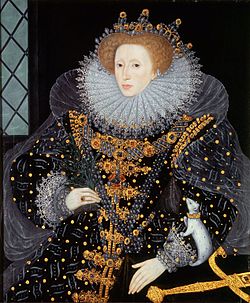
1-1550
|

2-1565
|

3-1572
|

4-1590
|

5-1590
|
|---|
1.English opulence, Italian reticella lace ruff, (possibly) Polish ornamentation, a French farthingale, and Spanish severity: The “Ermine Portrait” of Elizabeth I
2.Spanish fashion: Elizabeth of Valois, Queen of Spain, wears a black gown with floor-length sleeves lined in white, with the cone-shaped skirts created by the Spanish farthingale, 1565.
3.Elizabeth I wears padded shoulder rolls and an embroidered partlet and sleeves. Her low-necked chemise is just visible above the arched bodice, 1572.
4.Elizabeth Vernon at her dressing table wears an embroidered linen jacket over her rose-pink corset, 1590s.
5.In a typical hairstyle of the period, front hair is curled and back hair is worn long, twisted and wound with ribbons and then coiled and pinned up.
Men’s fashion
Overview
Men’s fashionable clothing consisted of a linen shirt with collar or ruff and matching wrist ruffs, which were laundered with starch to be kept stiff and bright. Over the shirt men wore a doublet with long sleeves sewn or laced in place. Doublets were stiff, heavy garments, and were often reinforced with boning. Optionally, a jerkin, usually sleeveless and often made of leather, was worn over the doublet. During this time the doublet and jerkin became increasingly more colorful and highly decorated. Waistlines dipped V-shape in front, and were padded to hold their shape. Around 1570, this padding was exaggerated into a peascod belly.
Outerwear
Short cloaks or capes, usually hip-length, often with sleeves, or a military jacket like a mandilion, were fashionable. Long cloaks were worn in cold and wet weather. Gowns were increasingly old-fashioned, and were worn by older men for warmth indoors and out. In this period robes began their transition from general garments to traditional clothing of specific occupations, such as scholars (see Academic dress).
Hairstyles and headgear
Hair was generally worn short, brushed back from the forehead. Longer styles were popular in the 1580s. In the 1590s, young men of fashion wore a lovelock, a long section of hair hanging over one shoulder.
Beards
Although beards were worn by many men prior to the mid-16th century, it was at this time when grooming and styling facial hair gained social significance. These styles would change very frequently, from pointed whiskers to round trims, throughout these few decades. The easiest way men were able to maintain the style of their beards was to apply starch onto their groomed faces. The most popular styles of beards at this time include:
Accessories
A baldrick or “corse” was a belt commonly worn diagonally across the chest or around the waist for holding items such swords, daggers, bugles, and horns.
Gloves were often used as a social mediator to recognize the wealthy. Beginning in the second half of the 16th century, many men had trimmed tips off of the fingers of gloves in order for the admirer to see the jewels that were being hidden by the glove.
Late in the period, fashionable young men wore a plain gold ring, a jewelled earring, or a strand of black silk through one pierced ear.
Style gallery
 1 –1550 |
 2 – 1566 |

3-1560
|
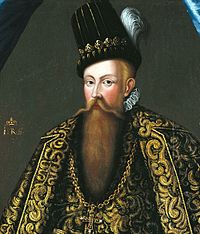
4-1560
|
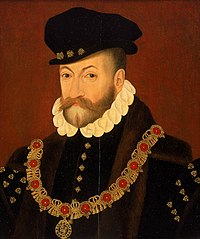
5-1575
|
|---|
1.King Edward VI of England wears matching black doublet, paned hose, and robe trimmed with bands of gold braid or embroidery closed with jewels, c. 1550.
2.Charles IX of France wears an embroidered black jerkin with long bases or skirts over a white satin doublet and matching padded hose, 1566.
3.Robert Dudley, Earl of Leicester in the narrow fashions of the 1560s: Ruff, doublet, slashed leather jerkin, and paned trunk hose with codpiece.
4.John III of Sweden wears an embroidered cape with a collar over his doublet.
5.The Earl of Lincoln wears a stiffened, gathered hat with a jeweled band. He wears the livery collar of the Order of the Garter c. 1575.
Footwear
Fashionable shoes for men and women were similar, with a flat one-piece sole and rounded toes. Shoes were fastened with ribbons, laces or simply slipped on. Shoes and boots became narrower, followed the contours of the foot, and covered more of the foot, in some cases up to the ankle, than they had previously. As in the first half of the century, shoes were made from soft leather, velvet, or silk. In Spain, Italy, and Germany the slashing of shoes also persisted into the latter half of the century. In France however, slashing slowly went out of fashion and coloring the soles of footwear red began. Aside from slashing, shoes in this period could be adorned with all sorts of cord, quilting, and frills. Thick-soled pattens were worn over delicate indoor shoes to protect them from the muck of the streets. A variant on the patten popular in Venice was the chopine – a platform-soled mule that raised the wearer sometimes as high as two feet off the ground.
Children’s fashion
Toddler boys wore gowns or skirts and doublets until they were breeched.
 1 – 1551 |
 2 – 1556–58 |
 3 – 1560 |
 4 – 1570 |
 5 – 1571 |
|---|
1.Francesco de Medici wears an unusual doublet (or robe?) that appears to fasten up the back, Italy, 1551
2.François Duke of Alençon, France, 1556–58
3.The French princess Marguerite of Valois wears a white gown with embroidery and pearls. Her hair is twisted and coiled against her head and pinned in place with pearls, 1560.
4.Italian children, c. 1570. The girls wear gowns of striped fabric trimmed with bands of black, with linen chemises and partlets.
5.Infantas Isabella Clara Eugenia and Catalina Micaela of Spain wear miniature versions of adult costume, including gown with hanging sleeves and Spanish farthingales, c. 1571. Their skirts appear to have tucks to allow them to be let down as the girls grow.
Working class clothing
 1 – 1565 |
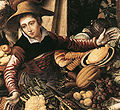 2 – 1567 |
 3 – 1568 |
 4 – 1580 |
|---|
1.German painting of the Last Supper in contemporary dress shows a table servant wearing pluderhosen with full, drooping linings, 1565.
Dutch vegetable seller wears a black partlet, a front-lacing brown gown over a pink kirtle with matching sleeves, and a gray apron. Her collar has a narrow ruffle, and she wears a coif or cap under a straw hat, 1567.
2.Flemish country folk. The woman in the foreground wears a gown with a contrasting lining tucked into her belt to display her kirtle. The woman at the back wears contrasting sleeves with her gown. Both women wear dark parlets; the V-neck front and pointed back are common in Flanders. They wear linen headdresses, probably a single rectangle of cloth pinned into a hood (note knots in the corners behind). Men wear baggy hose, short doublets (one with a longer jerkin beneath), and soft, round hats, 1568.
3.English countrywoman wears an open-fronted gown laced over a kirtle and a chemise with narrow ruffs at neck and wrists. A kerchief is pinned into a capelet or collar over her shoulders, and she wears a high-crowned hat over a coif, a chin-cloth, and an apron. She carries gloves in her left hand and a chicken in her right, c. 1555.
4.XVI Italy about the so-called “treccole”, women that sold food of any kind in the streets; respectable people tended to see their going around as a sort of cover for prostitution or loose behaviour.
Source from Wikipedia
